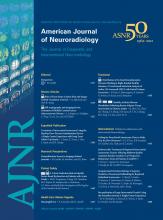Abstract
BACKGROUND AND PURPOSE: The clinical relevance of improved detection of cerebral microbleeds by using advanced-versus-conventional MR imaging techniques remains uncertain. As part of the population-based Rotterdam Scan Study, we compared whether participants whose microbleeds were only demonstrated on a high-resolution MR imaging sequence differed with respect to risk profile and risk of new microbleeds from participants whose microbleeds were also depicted on a conventional MR imaging sequence.
MATERIALS AND METHODS: Two hundred participants (mean age, 79.2 years) underwent both conventional 2D T2*-weighted MR imaging and high-resolution 3D T2*-weighted MR imaging at 1.5T. Vascular risk factors, APOE allele status, and markers of small vessel disease and risk of incident microbleeds were compared for microbleed status by using logistic regression models adjusted for age and sex.
RESULTS: There were no significant associations between any of the factors and microbleed presence in participants whose microbleeds were only demonstrated on a high-resolution MR imaging sequence. However, the estimates in these participants were more similar to those in participants whose microbleeds were also depicted on a conventional MR imaging sequence than to those in participants without microbleeds. Moreover, significantly more participants whose microbleeds were only demonstrated on high-resolution MR imaging developed new CMBs during follow-up compared with participants without CMBs (25.0% versus 5.9%; OR, 5.98; 95% CI, 1.35–26.49).
CONCLUSIONS: Improved detection of microbleeds may contribute to more accurate identification of persons with underlying small-vessel pathology in the general elderly population. Further studies are needed to replicate these findings and firmly establish the role of improved detection of CMBs in the identification of persons with vasculopathy.
ABBREVIATIONS:
- APOE
- apolipoprotein E
- CI
- confidence interval
- CMB
- cerebral microbleed
- GRE
- gradient recalled-echo
- OR
- odds ratio
- © 2012 by American Journal of Neuroradiology
Indicates open access to non-subscribers at www.ajnr.org











